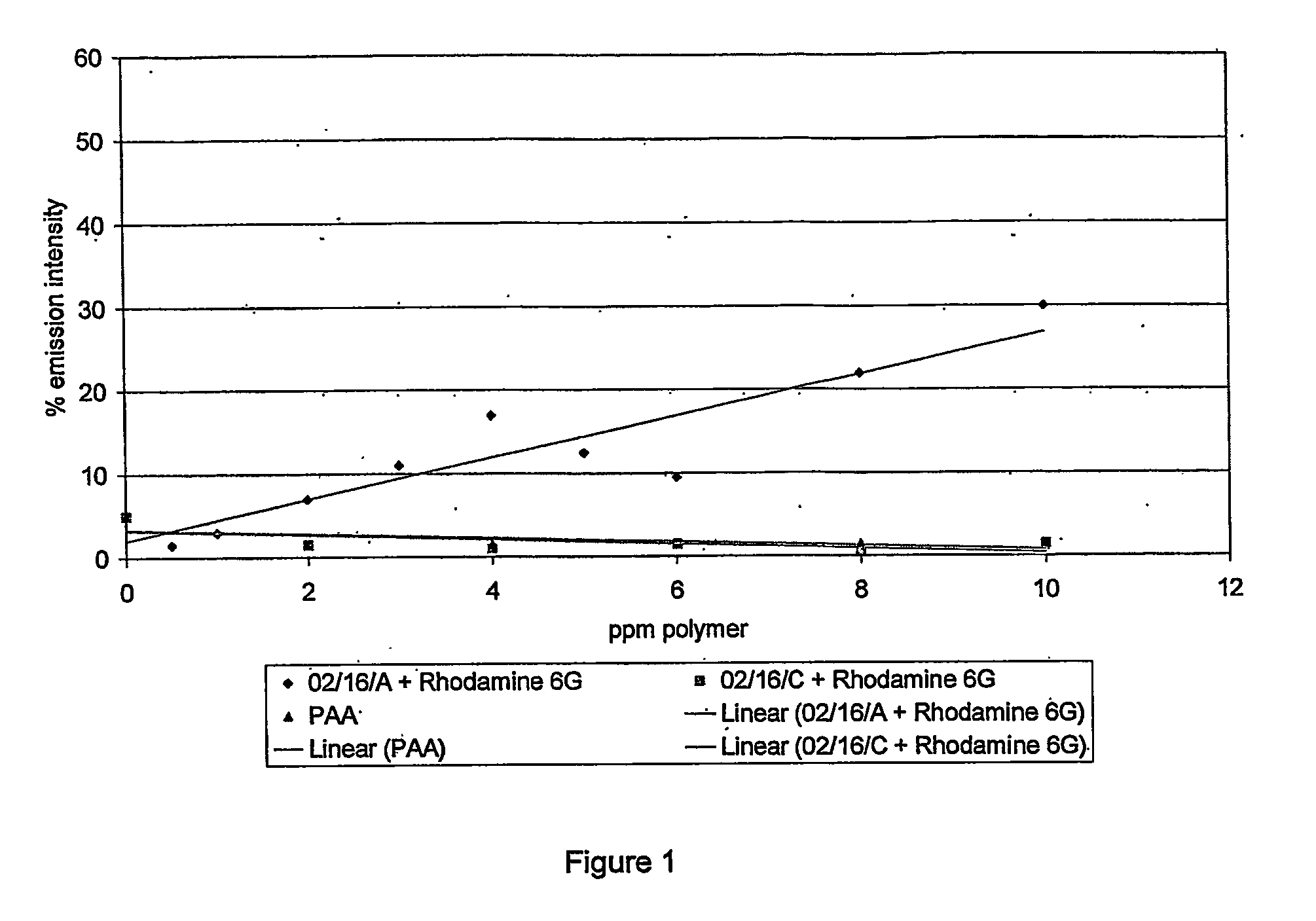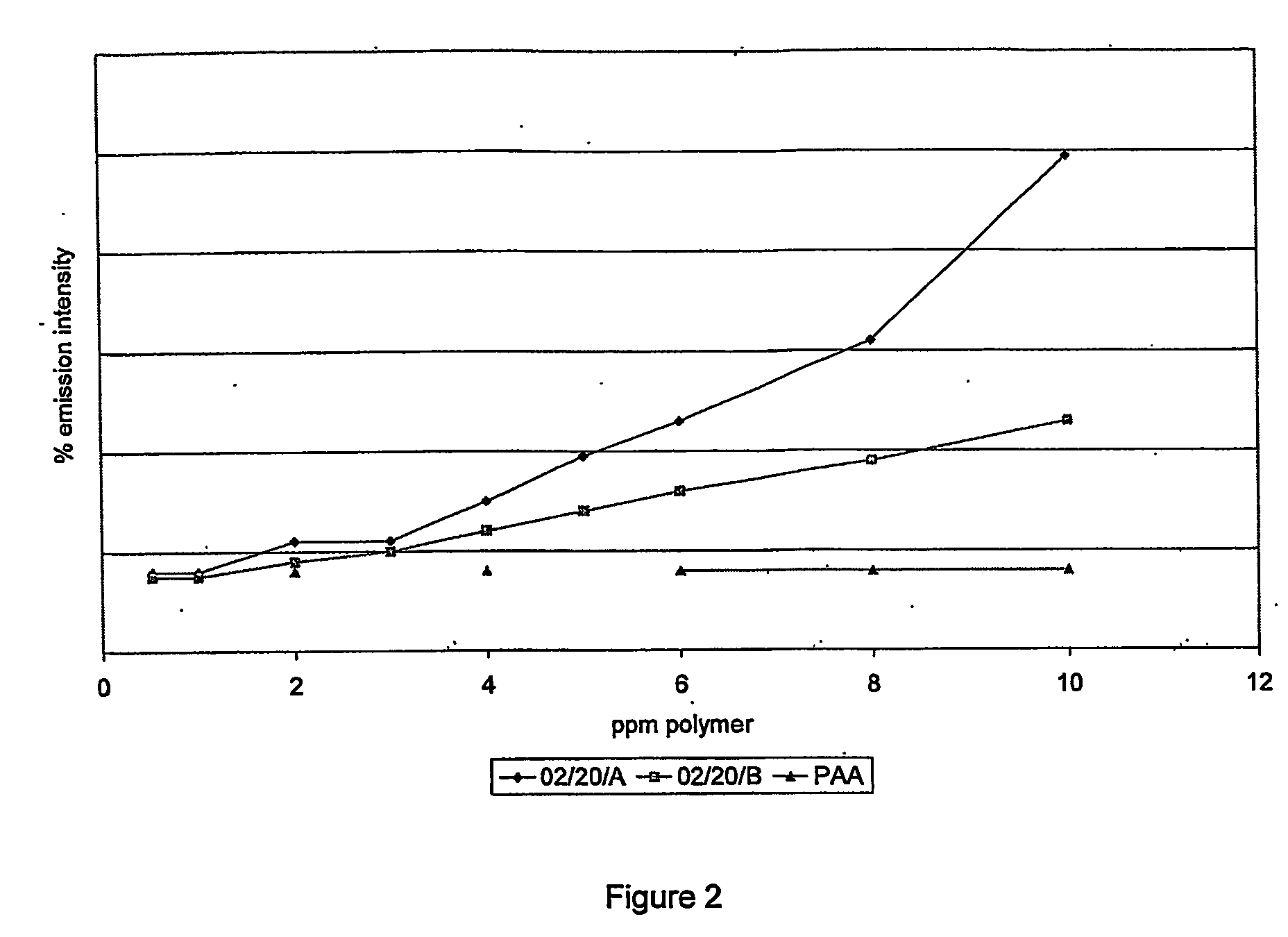Tagged scale inhibiting polymers, compositions comprised thereof and preventing or controlling scale formation therewith
- Summary
- Abstract
- Description
- Claims
- Application Information
AI Technical Summary
Benefits of technology
Problems solved by technology
Method used
Image
Examples
example 1
Preparation of a Tagged Scale-Inhibiting Copolymer: Co-Polymer of Acrylic Acid (AA) and Vinyl Benzyl Chloride (VBC) Converted to a Co-Polymer of Acrylic Acid (AA) and Rhodamine 6G (R6G)
[0129] The synthesis of this polymer was in two steps. The first was a co-polymerisation of M with VBC. A post polymerization nucleophilic substitution reaction across the VBC then attached the Rhbdamine 6G fluorescent molecule to the polymer.
[0130] A 4neck, 1 litre, quick-fit round bottomed flask fitted with a mechanical stirrer (Teflon blade) and reflux condenser was charged with 172.5 g of towns water and vinyl benzyl chloride (97%, Aldrich, catalogue number 33,872-9) as indicated in Table 1A. This was heated, with stirring, to 90° C. in a water bath controlled with a thermocouple. Once the vessel contents were at temperature, 238.4 g of the initiator (23% sodium bisulfite solution) and a solution of the chain transfer reagent (CTR), 11.7 g sodium persulfate, dissolved in 31.4 g towns water were ...
example 2
Preparation of a Tagged Scale-Inhibiting Copolymer: Co-Polymer of Acrylic Acid (AA) and 9-Vinyl Anthracene (9-VA)
[0134] A 4-neck, 1 litre, quick-fit round bottomed flask fitted with a mechanical stirrer (Teflon blade) and reflux condenser was charged with 172.5 g of towns water. This was heated, with stirring, to 90° C. in a water bath controlled with a thermocouple. Once the vessel contents were at temperature, 238.4 g of the initiator (23% sodium bisulfite solution) and a solution of the chain transfer reagent (CTR), 11.7 g sodium persulfate, dissolved in 31.4 g towns water were co-fed, at a constant rate, into the vessel over 6 hours using a peristaltic and syringe pump respectively. Fifteen minutes after the commencement of the initiator / CTR feeds, a mixed monomer feed of 534.8 g of acrylic acid and 9-vinyl anthracene (97%, Aldrich, catalogue number V170-8) as indicated in Table 2A was commenced and fed into the vessel, at a constant rate, over 5½ hours (finishing 15 minutes be...
example 3
Scale Inhibition Tests
[0137] The barium sulfate scale inhibition efficiency of all described polymers was determined using a static jar test method.
[0138] All polymers were purified to remove any unreacted monomer (including ‘tag’ monomer).
[0139] Purification was by precipitation of the polymer solution from ten times its volume of methanol. The precipitated polymer was recovered by filtration under gravity through a Whatman filter paper Grade GF / D. The purified polymer was redissolved in water. Precipitation was carried out a total of 3 times.
[0140] Static jar tests were conducted using a synthetic Forties-type formation water and North Sea seawater according to the brine chemistries in table 3A.
[0141] All salts were weighed into a beaker and made up with distilled water to just below 1 liter. The solution was stirred for at least 60 minutes before making up to exactly 1 liter with distilled water. Before use brines were filtered through a 0.45 μm filter under vacuum.
TABLE 3...
PUM
| Property | Measurement | Unit |
|---|---|---|
| Fraction | aaaaa | aaaaa |
| Percent by mass | aaaaa | aaaaa |
| Composition | aaaaa | aaaaa |
Abstract
Description
Claims
Application Information
 Login to View More
Login to View More - R&D
- Intellectual Property
- Life Sciences
- Materials
- Tech Scout
- Unparalleled Data Quality
- Higher Quality Content
- 60% Fewer Hallucinations
Browse by: Latest US Patents, China's latest patents, Technical Efficacy Thesaurus, Application Domain, Technology Topic, Popular Technical Reports.
© 2025 PatSnap. All rights reserved.Legal|Privacy policy|Modern Slavery Act Transparency Statement|Sitemap|About US| Contact US: help@patsnap.com



